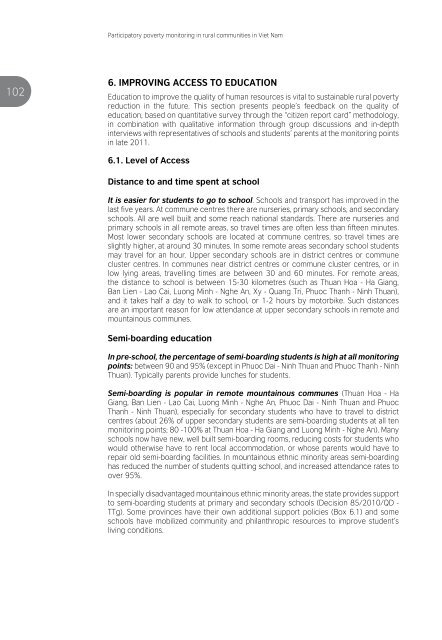Challenges to Rural Poverty Reduction in Viet Nam - Oxfam Blogs
Challenges to Rural Poverty Reduction in Viet Nam - Oxfam Blogs
Challenges to Rural Poverty Reduction in Viet Nam - Oxfam Blogs
Create successful ePaper yourself
Turn your PDF publications into a flip-book with our unique Google optimized e-Paper software.
Participa<strong>to</strong>ry poverty moni<strong>to</strong>r<strong>in</strong>g <strong>in</strong> rural communities <strong>in</strong> <strong>Viet</strong> <strong>Nam</strong><br />
102<br />
6. IMPROVING ACCESS TO EDUCATION<br />
Education <strong>to</strong> improve the quality of human resources is vital <strong>to</strong> susta<strong>in</strong>able rural poverty<br />
reduction <strong>in</strong> the future. This section presents people’s feedback on the quality of<br />
education, based on quantitative survey through the “citizen report card” methodology,<br />
<strong>in</strong> comb<strong>in</strong>ation with qualitative <strong>in</strong>formation through group discussions and <strong>in</strong>-depth<br />
<strong>in</strong>terviews with representatives of schools and students’ parents at the moni<strong>to</strong>r<strong>in</strong>g po<strong>in</strong>ts<br />
<strong>in</strong> late 2011.<br />
6.1. Level of Access<br />
Distance <strong>to</strong> and time spent at school<br />
It is easier for students <strong>to</strong> go <strong>to</strong> school. Schools and transport has improved <strong>in</strong> the<br />
last five years. At commune centres there are nurseries, primary schools, and secondary<br />
schools. All are well built and some reach national standards. There are nurseries and<br />
primary schools <strong>in</strong> all remote areas, so travel times are often less than fifteen m<strong>in</strong>utes.<br />
Most lower secondary schools are located at commune centres, so travel times are<br />
slightly higher, at around 30 m<strong>in</strong>utes. In some remote areas secondary school students<br />
may travel for an hour. Upper secondary schools are <strong>in</strong> district centres or commune<br />
cluster centres. In communes near district centres or commune cluster centres, or <strong>in</strong><br />
low ly<strong>in</strong>g areas, travell<strong>in</strong>g times are between 30 and 60 m<strong>in</strong>utes. For remote areas,<br />
the distance <strong>to</strong> school is between 15-30 kilometres (such as Thuan Hoa - Ha Giang,<br />
Ban Lien - Lao Cai, Luong M<strong>in</strong>h - Nghe An, Xy - Quang Tri, Phuoc Thanh - N<strong>in</strong>h Thuan),<br />
and it takes half a day <strong>to</strong> walk <strong>to</strong> school, or 1-2 hours by mo<strong>to</strong>rbike. Such distances<br />
are an important reason for low attendance at upper secondary schools <strong>in</strong> remote and<br />
mounta<strong>in</strong>ous communes.<br />
Semi-board<strong>in</strong>g education<br />
In pre-school, the percentage of semi-board<strong>in</strong>g students is high at all moni<strong>to</strong>r<strong>in</strong>g<br />
po<strong>in</strong>ts: between 90 and 95% (except <strong>in</strong> Phuoc Dai - N<strong>in</strong>h Thuan and Phuoc Thanh - N<strong>in</strong>h<br />
Thuan). Typically parents provide lunches for students.<br />
Semi-board<strong>in</strong>g is popular <strong>in</strong> remote mounta<strong>in</strong>ous communes (Thuan Hoa - Ha<br />
Giang, Ban Lien - Lao Cai, Luong M<strong>in</strong>h - Nghe An, Phuoc Dai - N<strong>in</strong>h Thuan and Phuoc<br />
Thanh - N<strong>in</strong>h Thuan), especially for secondary students who have <strong>to</strong> travel <strong>to</strong> district<br />
centres (about 26% of upper secondary students are semi-board<strong>in</strong>g students at all ten<br />
moni<strong>to</strong>r<strong>in</strong>g po<strong>in</strong>ts; 80 -100% at Thuan Hoa - Ha Giang and Luong M<strong>in</strong>h - Nghe An). Many<br />
schools now have new, well built semi-board<strong>in</strong>g rooms, reduc<strong>in</strong>g costs for students who<br />
would otherwise have <strong>to</strong> rent local accommodation, or whose parents would have <strong>to</strong><br />
repair old semi-board<strong>in</strong>g facilities. In mounta<strong>in</strong>ous ethnic m<strong>in</strong>ority areas semi-board<strong>in</strong>g<br />
has reduced the number of students quitt<strong>in</strong>g school, and <strong>in</strong>creased attendance rates <strong>to</strong><br />
over 95%.<br />
In specially disadvantaged mounta<strong>in</strong>ous ethnic m<strong>in</strong>ority areas, the state provides support<br />
<strong>to</strong> semi-board<strong>in</strong>g students at primary and secondary schools (Decision 85/2010/QD -<br />
TTg). Some prov<strong>in</strong>ces have their own additional support policies (Box 6.1) and some<br />
schools have mobilized community and philanthropic resources <strong>to</strong> improve student’s<br />
liv<strong>in</strong>g conditions.

















